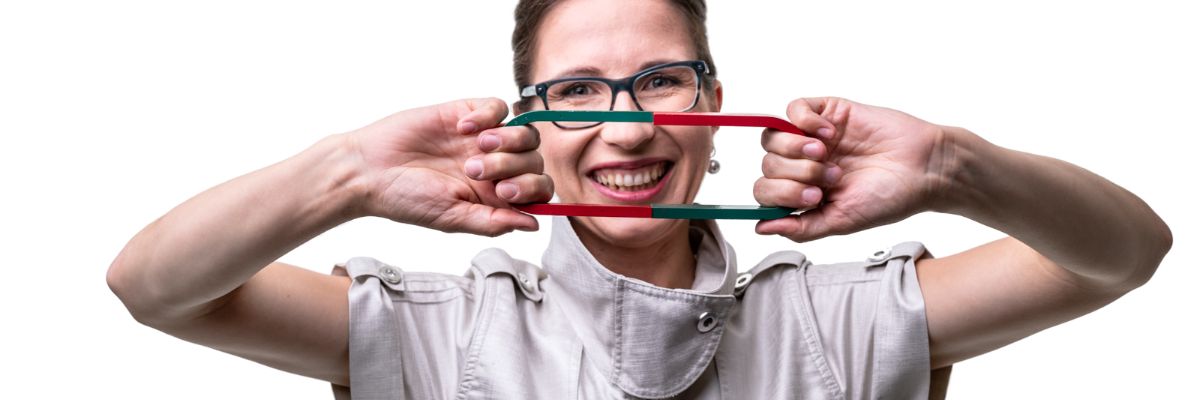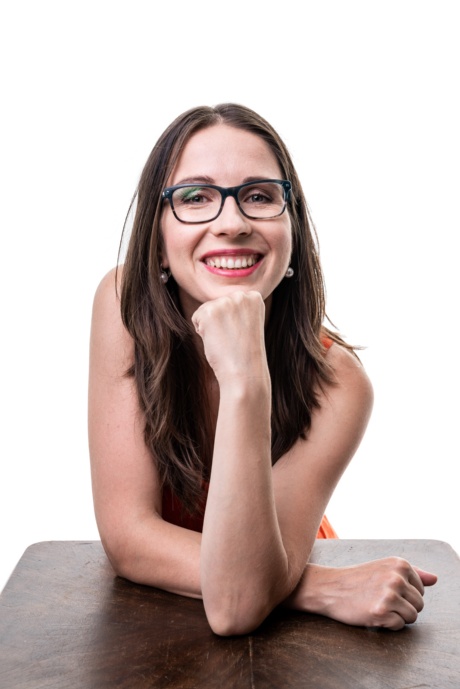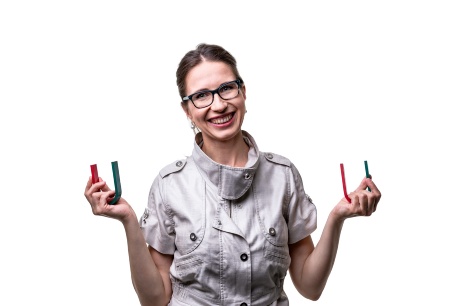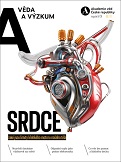
Many avid researchers decide to stay in the Czech Republic, says Reichlová
08. 03. 2023
After working in Germany and the USA, she returned to the Czech Republic in 2022. She is now a lecturer at the Technical University Dresden and her research focuses on spintronics, specifically spin caloritronics. Helena Reichlová, an award-winning researcher working at the Institute of Physics of the CAS, is pioneering a new direction in her field of research while remaining an indomitable optimist.
*
Almost ten years ago, you spent one year on a Fulbright scholarship at Ohio State University in the USA as part of your doctoral studies. A documentary film about your trip was made, which can be watched on Czech Television’s website. Perhaps surprisingly, my first question is not about science, and I’d like to ask: what was the filming itself like for you?
I admit that it was a bit of a professional shock. I had no idea how much difference there is between analytically rational individuals working in science versus the art industry, where everything is based more on emotions. I was given a lot of what I found to be unusual questions, such as, “How did this experiment make you feel?” I had never thought about that before – what my experiments made me feel. I was always interested to know how the experiment would turn out. But it was definitely an interesting experience, and if it convinced just one person that maybe it would be worth pursuing science, going on a Fulbright, and seeing the world, then it was worth it.
I’m sure it was. I read an interview with Milan Heczek from Brno University of Technology, who mentioned that it was your story that inspired him to apply for a Fulbright scholarship.
Several students have actually contacted me and asked how to go about it. I’m glad I can give young people a “push” to go abroad to gain experience – it broadens their horizons. That’s very important. Plus, when a Fulbright is timed well, it can change a person’s perception of where they want to go in life, help them make connections. For me, it was a formative experience. I experienced how research can be conducted on a professional level. It convinced me that my calling was in science.
Why do you want to do it?
I would love for our research to be useful one day. I’m an indomitable optimist, so I firmly believe it will be. What’s important to me is the idea of giving back to society the considerable resources it invests in science. That’s the wonderful thing about science – most of the people I meet are motivated by the desire to advance knowledge and to help society and, by extension, humanity. And that’s my type of motivation, no “I want to make more money in the stock market” or toiling away my eight hours and going home.
And from your experience – is this approach universally prevalent, or is it stronger in the Czech Republic because the pay is lower here?
In the Czech Republic, there’s a huge number of researchers who live and breathe for science. It’s a very nice environment. I found it was similar in Germany. The situation was a little different in the US. But when I was there, I was younger and many of my colleagues were students who then went on to work for private companies. The truth is that there are more companies in the US than in Europe that hire PhD graduates straight out of school and offer interesting opportunities in the field of research.
You mentioned Germany, where you were working until recently. How long were you there?
For more than four years, and it’s far from being a closed chapter for me. I’m still in Dresden as a visiting researcher, and I have students there and a lot of equipment. I go there about every two weeks for two, three days. Dresden is close – the trip there is quicker from Prague than if you were going to Brno, just an eighty-minute drive...

Experimental physicist Helena Reichlová works at the Institute of Physics of the CAS. (CC)
Not everyone would return to the Czech Republic with such an experience. And your partner Dominik Kriegner is Austrian and also a researcher, perhaps Germany would’ve been a more familiar environment to him than the Czech Republic. So what brought you back to Prague?
We always wanted to return to Prague, it was always the plan from the beginning. My research group at the Institute of Physics of the CAS is truly one of a kind. We’re a good fit in terms of personalities and subject-wise. There’s a balance of stability, cutting-edge research, and a friendly environment here, so we didn’t even consider settling elsewhere. And of course there’s also the parameter of family to consider. We have our support system and family in the Czech Republic, and Austria is close. My partner and I agreed that it was more important for us whether we looked forward to going to work than whether we earned more.
If you had decided to stay in Germany, would your income have been significantly different?
Definitely. You’d think that in Germany, although the wages are higher, the cost of living is also higher. However, this is not entirely true anymore. Wages are indeed much higher there, but the living expenses are now comparable to the Czech Republic. We paid 650 EUR for a rented three-room apartment in Dresden, which is comparable to current rent prices in Prague.
We pay rent almost 1,000 EUR for a three-room apartment in Prague.
Well, there you have it! Plus the cost of food, gas, and furniture is the same as in the Czech Republic. The only thing you might save on in the Czech Republic is the hairdresser, and that’s only maybe 20 EUR at best. On the other hand, in Germany there is a huge mobility in science. You have to be prepared to uproot yourself every five years. But we wanted to offer our children a more stable environment when they hit school age. We didn’t want to have to tell them to “pack your bags, we’re moving away” once they managed to make friends.
You’ve been back in the Czech Republic for a relatively short time, but as you mentioned, you haven’t cut ties with Dresden. To what extent will your research here and in Germany overlap or even compete?
So far we’ve worked mainly in Dresden. Now in Prague we’re building special equipment for our measurements. At the Institute of Physics of the CAS, the conditions in the laboratory allow us to go to higher temperatures, while in Dresden we get to work with a stronger magnetic field. My dream is that my students will travel from Germany to the Czech Republic for certain measurements and vice versa as needed. The geographical proximity makes this possible and at the same time the two workplaces wouldn’t have to buy the same equipment – we could complement each other.
That brings us into the lab. Before we explain exactly what you are researching, we need to paint our readers a picture. Your field is spintronics, or more specifically, a subfield of spintronics. Let’s talk about that.
The aim of spintronics is to harness the intrinsic spin of the electron, a quantum property of electrons. A lot of great spintronic components are already being used in electronics today. Spintronics is also often discussed in the context of computer technology of the future. For example, computer memory could be faster with zero energy consumption in standby mode. However, spin is controlled, written, and read using electrical current, which of course always consumes energy.
And it is the consumption of energy that worries you...
Yes. Computer technology is expanding – we depend on it and it brings us many benefits. But there are limits to that growth. Most often we talk about physical limits: how much the components can be integrated together. The second barrier, which we’ve started to address in the past decade, is the energy intensity of electronic devices. That we’ll upgrade to a smart washing machine and iron is fine, we’re at least assured our apartment won’t burn down, but all these electronics come with extra energy consumption, not to mention autonomous cars, and data centres especially. All these things use an awful lot of energy. And personally, it’s this energy parameter, that it consumes so much of our resources, which motivates me – there are different ways to work on this issue, and we’re researching one of them.
So you’re attempting to control spin with something other than electricity?
We control it by means of a temperature gradient. It’s called spin caloritronics, which is a smaller field, but I’m really interested in it because it offers a direct answer to humankind’s enormous energy consumption. Most electronic devices generate waste heat, and if it could be utilised for some function, like reading or writing data, instead of being emitted into the air or converted back into electricity, that would be great. And we’re just trying to figure out how to do that as efficiently as possible. To find better materials for spintronics, to find other effects that could help us better utilise the temperature gradients in the components.
Perhaps we should specify what a temperature gradient means...
It’s nothing more than a difference in temperature. If you have a component that generates heat, you step away from it and connect it with a temperature conductor, the temperature difference between the hot and cold ends can control the spin of the electrons.
So just the difference in temperature of any two locations is enough to serve as a power source for a spintronic component?
Bingo. If you think about the huge amount of heat we generate all over the place, any small function that could harness it would be of great benefit.

Giant data centres are huge energy “guzzlers”.
Let’s take a look inside the lab. How exactly is the new material examined?
First, we need a temperature gradient. Using lithography, we create a small wire through which we conduct an electric current for lab purposes. That generates heat which spreads through our sample. By the way, size-wise we’re talking about, say, 50 micrometres only. We can also generate temperature gradients with a laser.
And the sample itself is examined how?
Because we’re interested in the spin, we want to set it in motion in some way – we use a magnetic field to do that. We change its intensity, direction, and temperature while observing how the voltage changes.
So according to the voltage, you can tell what’s happening to the spins? Whether they’re oriented in the same direction, for instance?
It’s more about observing whether they’re moving in a certain direction. We’d like the spins to be moving somewhere, for instance, to turn in a certain direction. An electron with a certain spin goes one way while another goes the other way. So if you have multiple electrons in a conducting sample with one particular spin oriented to one side, they will turn somewhere and there will be more of them there than on the opposite side. And it’s the difference in that number of electrons that creates the voltage.
So you’re not looking at the electron’s spin per se?
There is a large number of techniques that are used to study the spin itself, which I won’t bother mentioning so as not to make it too complicated. For example, we would like to study spin caloritronics in insulators where there are no free electrons available to carry information. This is instead transmitted by so-called magnons – which we can imagine as waves. The spin is like a piece of information that can be transmitted by means of a wave. Such a wave can even carry information by means of a non-conducting material to our detector.
I imagine it like a football stadium. The sports fans represent the electrons, and the spin, a property of electrons, determines whether their arms are raised into the air or not. The moment they raise their arms, a Mexican wave runs through the stands – and you can observe it, even though the electrons themselves, or the sports fans, are not moving and are in their seats...
Yes, exactly, that’s the simplest version of magnon propagation. In reality, the situation is then complicated by the additional degrees of freedom of the spin (they can tilt, rotate, etc.) and the wave could propagate due to the fans’ arms being tilted to various degrees...
What materials do you use for your samples?
Various materials. This is one of the biggest challenges: identifying suitable materials for future applications. We have to look at the thermal and electrical conductivity of the material, the so-called Seebeck coefficient, along with other parameters that usually go against each other. Ideal materials are those which are neither completely metallic nor completely insulating. Typically, it is semi-metals and semiconductors that have the greatest efficiency for converting heat to voltage. At the same time, they must be magnetic, i.e., have a certain arrangement of the electrons’ spins so that we can then write and read the information.
How does the writing work?
Ferromagnets are used – i.e., what most people think of when they picture a magnet. An electric or magnetic field is used to orient the spins in a particular direction. The advantage is that such a material remains oriented the same way even after writing. This is why the memories in hard disks retain information even after the computer is turned off. What we want to do is to expand from ferromagnets to antiferromagnets. There is a very strong research group here at the Institute of Physics of the CAS working on antiferromagnetic spintronics, and our research can work in perfect synergy with it, making use of the findings that are already there.
So a ferromagnet is a normal magnet, and in its lattice the spins are all ordered in the same direction. What’s the situation regarding the antiferromagnets you mentioned?
These are materials that also have spins aligned in patterns, but the direction of the spins alternates in the crystal lattice from one atom to the next. So on the surface, they appear to be non-magnetic. For a long time, they were considered useless for any potential applications, but that’s changed in the past 15 years thanks to the department led by Tomáš Jungwirth at the Institute of Physics. The thing is, you don’t need the material to be externally detectable, but to be able to write something into it and read it. And as long as those two things are met, it doesn’t matter what the material on the outside is. There are several ways to do this, even with antiferromagnets, and they work.
What are the advantages of these materials?
Externally, they are not magnetic – that is, you can’t simply erase or affect them. There are many more materials in existence that are naturally antiferromagnetic than ferromagnetic. Their frequency is also higher than that of ferromagnets, so spin flipping can take place faster and writing is accelerated.
How much of your work is done in the lab versus on the computer?
I could do with getting into the lab more often... (smile) But now I’m at a phase where I’m often at the computer, writing papers, grant applications, etc. I’m really looking forward to the lithography, where the components are made. I’m looking forward to putting on all those layers and making a sample. It’s a simple layer of material, only about twenty nanometres thick, and we then take it to the lithography machine where we can draw what we want. Afterwards, we use chemicals to get rid of the material in places where we don’t want it to be. Then we add another layer, as if we were assembling a sandwich. We constantly check the process in the microscope – whether we have removed the material where we want it or elsewhere. And the result is a tangible thing, the product we wanted. I enjoy doing that.
From your résumé, one gets the sense that when you’re not in the lab or at your computer, you’re in the middle of accepting one prize or another. You’ve won several awards in your relatively short career as a scientist. For example, the Milan Odehnal Award, the Minister of Education, Youth and Sports Award for outstanding students and graduates, the Česká Hlava Foundation Award – the Doctorandus Award for Natural Sciences, and this year, you received the Otto Wichterle Award. Which one do you value the most?
Did you know that I was just thinking about this myself? For most of the mentioned prizes, I had to apply, I had to “sell” my achievements, or someone had to nominate me. The only prize I didn’t apply for was the one from the American Physical Society for exceptional scientific article reviewing. I was very happy about that one. But in general, I of course appreciate all of them greatlz, because they’re an important motivator for my work. During a scientific career, you will experience many, many rejections, so any award or recognition always goes a long way. So I advise my students to apply for various prizes and scholarships as much as they can...
What fulfils you besides work? You make no secret of the fact that you enjoy rock climbing.
My partner and I still go climbing, it’s our shared hobby. Although we have less time for it with the kids. During the year we visit rock climbing gyms and in the summer we try to get to the Alps, but we’re climbing less these days.

Helena Reichlová has received many prestigious awards, from the Česká hlava to a Fulbright Scholarship and recognition from the American Physical Society for exceptional scientific article reviewing. (CC)
What type of climbing do you do?
I have always liked multi-pitch climbing the most. Trips where you choose a mountain, you get there with a rope, you climb thirty meters, then you stop at a belay station, have a drink and a snack, then climb another section...
So, it’s a day-long sort of trip?
Yeah, sort of. And it’s not just an up and down climb; you have to pull out the rope several times to use it for the next section. All in all, you might climb about 200 metres. But we’ve always preferred safe, easy routes involving scrambling and hiking more than anything else, where you can enjoy the mountains and not get into risky situations.
So you’re not afraid of heights?
When there’s a difficult section to climb, I do get scared. Not so much of the heights, but when you find yourself somewhere far above the belay, there’s the fear of falling, getting scraped up, not knowing how to climb back up... but that’s all part of it, and we choose routes where the risk is proportional to our abilities. It’s meant to be stress-relieving, not stress-inducing.
Since we mentioned children – you’ve admirably managed to combine motherhood with a scientific career, which is not exactly common. How does one go about achieving that?
First of all, you need an understanding partner. It’s also ideal if you have “babysitting grandparents” willing to help out. We’re lucky to have two amazing grandparents. That’s really priceless help that not everyone has, unfortunately. And the third thing is the people at work – supervisors and colleagues. If they allow you to schedule part-time work and combine that with flexible working hours. When my son was born, we used to hire a nanny occasionally. I was working at the Institute of Physics, and when the nanny wasn’t available, I would schedule my day differently or work from home. It’s a bit precarious, but I think with the support of family and supervisors, the situation can somehow be managed. However, in the Czech Republic in particular, I didn’t feel that support from the state was adequate for parents with children under the age of two. I would actually recommend anyone with a child aged one and up to be on a postdoc in Germany. There, kindergartens for kids from the age of one and up are a given! And you don’t have to justify to anyone there that you are “already” going back to work. It’s considered perfectly normal there.
Which is of course a great relief, I imagine. In the Czech Republic, it’s even a problem to find a preschool for a three-year-old...
It’s definitely nice to have a choice. If someone wants to stay at home with their child(ren) for three years, that’s perfectly fine. But it should be considered just as fine to stay at home for a year and then have your child go to a state-funded preschool. When we recently returned to the Czech Republic, everyone laughed when we wanted to apply for a state-funded preschool, my daughter being two-and-a-half years old. We eventually found a fantastic private preschool, but it’s seriously expensive. In the end we got lucky and got into the Pluto daycare group for children run by the Czech Academy of Sciences. However, it was preceded by a very competitive interview, and we felt nervous about appearing before the grant committee. We had to explain how our research work would be affected if our daughter didn’t get into the daycare group. We take it as a great appreciation of our work that we succeeded and got the spot. We might start listing that on our resume, too (laughs).
So, in your case, the Czech Academy of Sciences, which offers the possibility of children’s (daycare) groups, was of some help...
Yes, without that, it would’ve been difficult to figure out. The state isn’t working with this under-the-age-of-three preschool system. I never looked into it, but it seems to me that nursery schools for children of a younger age make sense economically.
Certainly, there are expert studies on this, including from the Economics Institute of the CAS (CERGE-EI), which clearly show that it is worthwhile for the state to have universal state preschools from an early age, so that parents have the opportunity (not the obligation) to return to work...
In our situation, babysitting grandmas bear the brunt of it along with my partner, who is also a scientist and gets it. In a typical family, I guess the mother doesn’t have much opportunity to go back to work early. And if she has a second child, it totals a period of five or six years... If I left science for that amount of time, I think I’d have a hard time coming back without falling off the top ranks in all the evaluations... I wouldn’t want to try; I’d be a little afraid of failing to get back into it. I think state-funded preschools should be a priority, because it would enable mothers who want to work to be able to. So that it all didn’t have to depend on supervisors who are understanding of the situation, enlightened institutions setting up daycare groups, or superhero grandparents.
Perhaps the current economic crisis will force politicians to prioritise such a decision. You left for Germany when your son was a year old, and your daughter was born in Germany. How was your return to work after that?
From the time my daughter was six months old, I received a stipend for a paid nanny and household help. After four months of parental leave, I was able to return to the office for shorter instances, and after one year, we had a guaranteed place for my daughter in a state-run preschool. If it hadn’t taken an hour and a half to get to Dresden, we might have even considered commuting there from Prague by car (laughs).
We started the interview talking about your Fulbright scholarship and the TV documentary that was made about it. At that time you were already in a relationship with your current partner, that was followed by a year of being in separate countries, then four years together in Germany... What’s your recipe for a happy relationship?
Ask people who have been together for 50 years (laughs). I guess it’s because we’re both pretty rational. We have so many common interests and topics to discuss. Of course, we inevitably talk about work at home and vice versa. A lot of people wouldn’t want to put up with that, but I don’t mind. Sometimes at work we talk about the kids or that we should get the carpet cleaned. And at home, instead of the carpet, we talk about physics.
What language do you speak at home, anyway?
When the kids are home, we try to speak German. The kids don’t like it when they can’t understand what we’re saying. But if my partner and I are alone, we speak English, since English is a foreign language for both of us. For example, I know that my partner has to speak at a different level of German with me than he would with his friends. So there is a certain asymmetry when you have to speak with your partner as if with a little child.
What about the kids?
We didn’t want to define who they are by their choice of country or school. We didn’t want to say, ‘we’re going to live in the Czech Republic now, so you’re going to have a complete education in Czech and you’re going to become Czech’. They are Czech-Austrian, so if they want to go to high school in Austria one day, for instance, they have that option. We enrolled our son in a Czech-German primary school in Prague and from September, he will be taught half in Czech and half in German. We have a good feeling about the school and it resonates a lot with our approach. It’s not quite ‘do whatever you want, kids’, but they try not to have such a distanced relationship with them as is common in a regular school. You can see that the teachers there are motivated. But maybe I just see all these plans as overly optimistic as is typical for me.
The interview with the young researcher was published (in Czech) in the CAS magazine A / Věda a výzkum.

3/2022 (version for browsing)
3/2022 (version for download)
Prepared by: Viktor Černoch, Division of External Relations, CAO of the CAS
Photo: Jana Plavec, Division of External Relations, CAO of the CAS; Shutterstock
 The text and photos marked (CC) are released for use under the Creative Commons license.
The text and photos marked (CC) are released for use under the Creative Commons license.
Read also
- A trapped state: The pandemic impact on public attitudes, trust, and behavior
- Aerial archaeology: Tracing the footsteps of our ancestors from the sky
- Archaeologists uncover ancient finds along Prague Ring Road
- Our microbiome largely depends on what we eat, says microbiologist Michal Kraus
- The ABCs of writing: Why did its invention mark a turning point for humankind?
- We learn, remember, forget… What can memory actually do? And can we outsmart it?
- New Center for Electron Microscopy in Brno opens its doors to global science
- The hidden lives of waste: What can we learn from waste workers and pickers?
- A unique lab is hidden right beneath Prague’s Vítkov Hill
- Renewables are a strategic investment in European security, scientists say
The Czech Academy of Sciences (the CAS)
The mission of the CAS
The primary mission of the CAS is to conduct research in a broad spectrum of natural, technical and social sciences as well as humanities. This research aims to advance progress of scientific knowledge at the international level, considering, however, the specific needs of the Czech society and the national culture.
President of the CAS
Prof. Eva Zažímalová has started her second term of office in May 2021. She is a respected scientist, and a Professor of Plant Anatomy and Physiology.
She is also a part of GCSA of the EU.